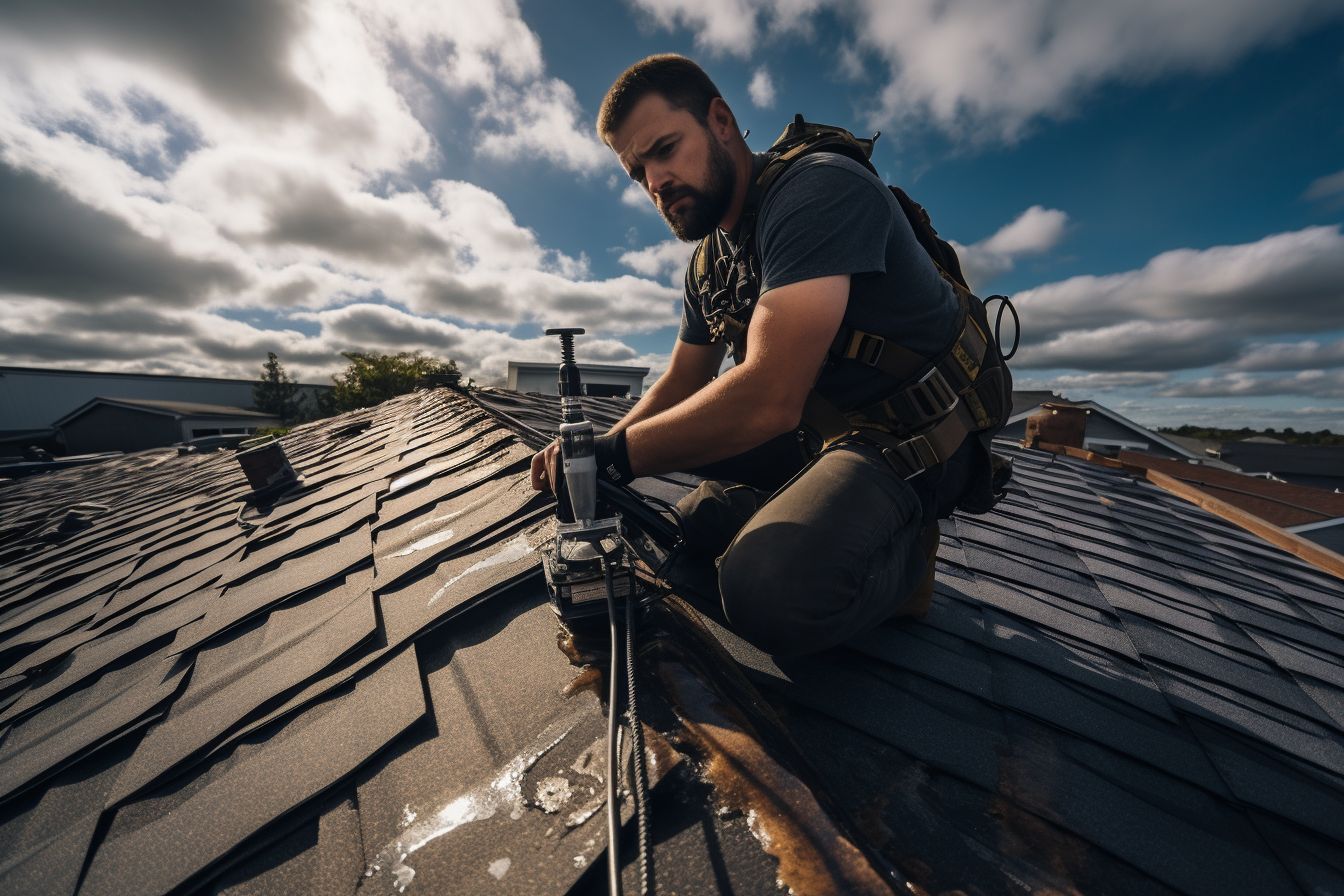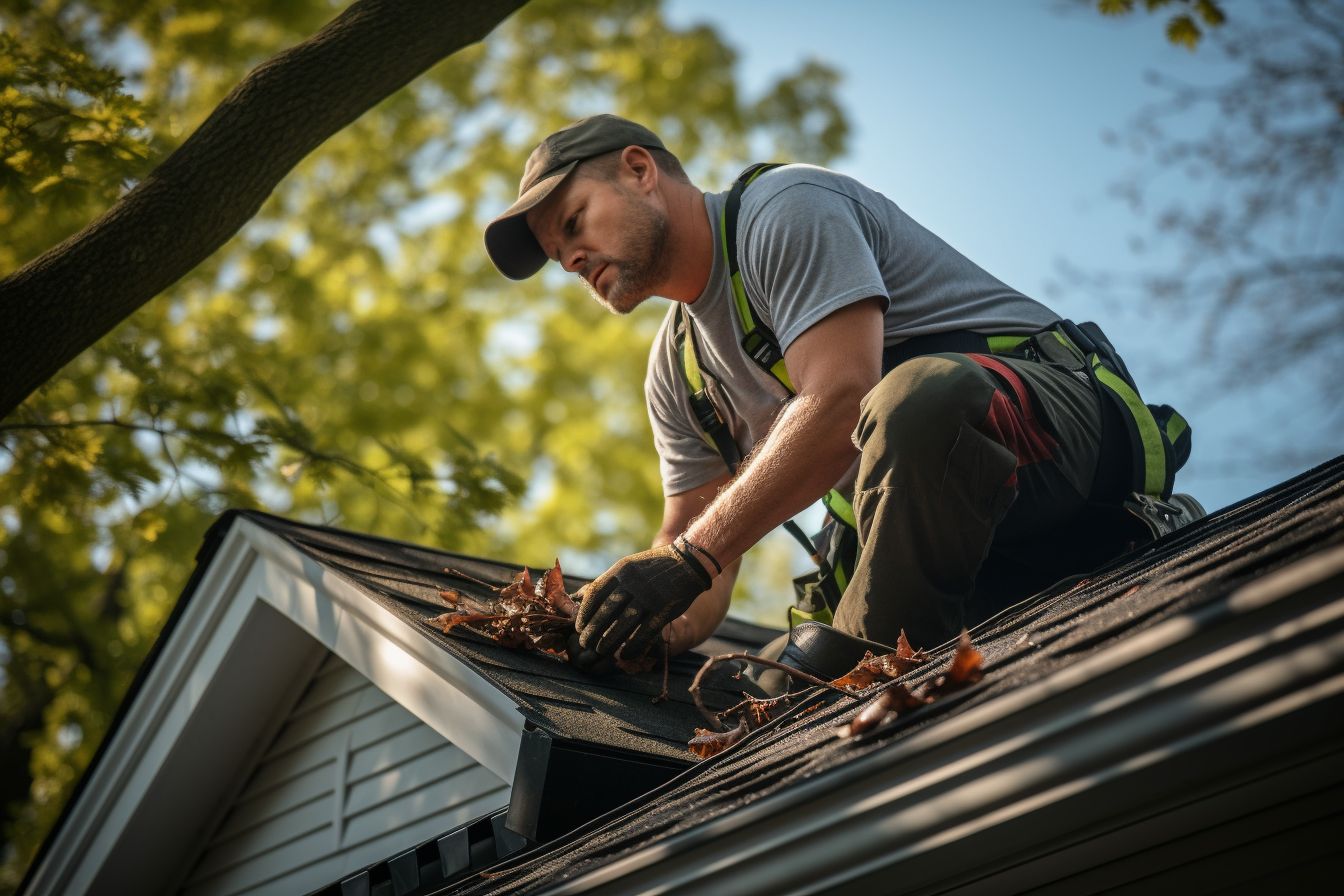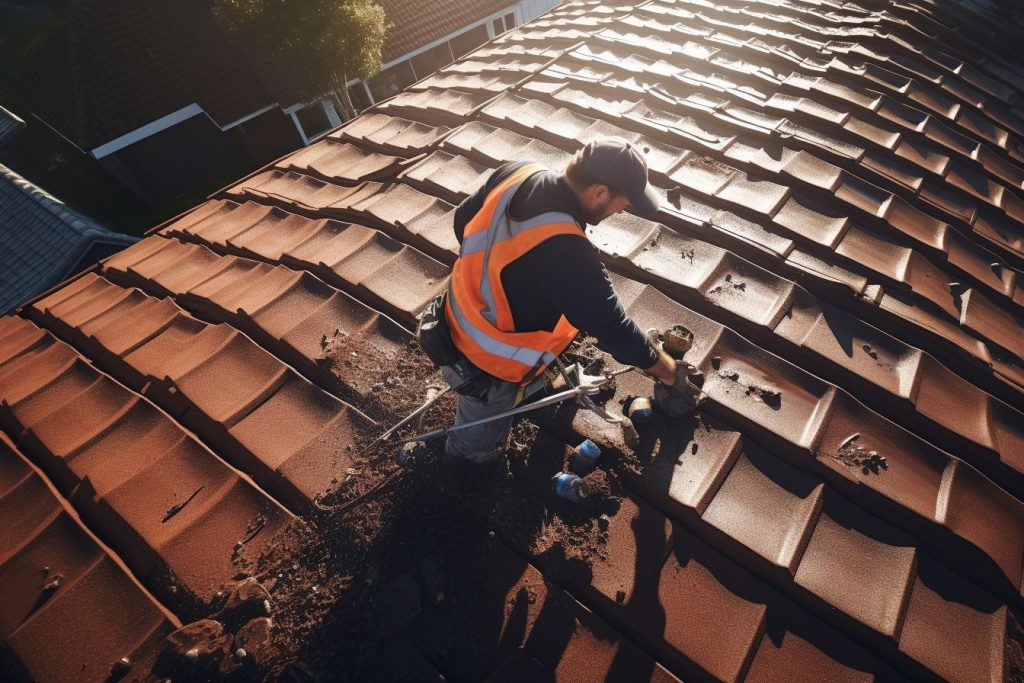Dealing with roof leaks can be a major headache for homeowners. Did you know ignoring them may lead to more severe and costly damage? This blog post outlines step-by-step instructions on effectively sealing roof leaks, offering practical tips on the best sealants and preventive measures.
Start reading now – your hassle-free guide towards a leak-free home is just a scroll away!
Key Takeaways
- Finding the source of a roof leak is crucial; inspect your attic and look for water stains or mould to pinpoint the area.
- Prepare the leak area by removing shingles, cleaning debris, and soaking up standing water.
- Apply the correct sealant or patch, like Gorilla Waterproof Patch & Seal Tape, with steady pressure to effectively seal roof leaks.
- Inspect and test the repair by checking for additional cracks or weaknesses and simulating rainfall to ensure it is adequately sealed.
Homeowner’s Manual: Handling Roof Leaks

Roof leaks can lead to significant water damage if not addressed promptly. A crucial first step involves finding the source of the leak, often signalled by dark or bulging spots on the interior ceiling.
Once you identify this, mop up any standing water and prepare for repair.
For small leaks, roof cement or a waterproof sealant might suffice to prevent further penetration. The area surrounding the leak should be cleaned thoroughly before applying any kind of coating material.
A common mistake made during this phase is skipping moisture absorption before securing with a waterproof cover; it’s recommended to soak up as much water as possible first.
In some instances, professional help from roofing contractors may be required – especially when dealing with leaks or more significant issues beyond minor repairs. Proper roof maintenance, including regular inspection, can also play a key role in preventing future problems associated with water penetration into your home through your roof.
Steps to Seal Roof Leaks

To seal roof leaks, follow these steps: find the source of the leak, clean and prepare the area, apply roof sealant or patch, and inspect and test the repair.
Could you find the source of the leak?
Locating the source of a leak is more complex than it might seem. Water stains on your ceiling or walls are apparent signs of roof damage and can guide you to where water leakage occurs.
The tricky part, however, is that water travels before it drips down visibly, meaning the actual leak could be located at a different spot on your roof.
I think exploring your attic can provide essential clues in this detective work. Search for water stains or mould with a flashlight, commonly indicating a leak. Keep an eye out for any penetrations in your attic insulation, such as holes, plumbing vents or anything that projects through the roof.
These items are frequently found to be the source of leaks because they disrupt an otherwise solid surface area, making them vulnerable points for rainwater penetration.
Clean and prepare the area
You can start the process by removing shingles from the suspected leak area. This step assists in revealing any underlying issues, making it easier to pinpoint precise damage areas. Then, eliminate debris, such as leaves and twigs, that could hide potential problems.
A clean roof ensures a proper grip for the sealant or patch you will apply later. It’s crucial to soak up standing water with absorbent fabric or sponges before covering it with a roofing material. This prevents moisture from being trapped underneath and causing further damage.
The whole rooftop needs thorough cleaning, scraping, and sweeping preparation for an effective leak repair job. These actions keep your roof well-maintained while boosting the longevity of your waterproofing efforts.
Could you apply roof sealant or patch?
Applying the proper roof sealant or patch is essential to seal roof leaks effectively. One recommended option is the Gorilla Waterproof Patch & Seal Tape, which features adhesive backing that sticks firmly to leaks and vulnerable seams on your roof.
When applying the sealant or patch, use steady pressure to force it into the joint for maximum effectiveness. Additionally, protect any open products and tools from direct exposure during the application process.
Remember, if you have tiny holes or flashing isn’t an option, caulk can also be used as a leak stopper. Using the proper sealant or patch and taking these precautions can effectively prevent further damage caused by roof leaks.
Inspect and test the repair.
Inspecting and testing the repair is crucial, and silicones seal roof leaks. Once you have found and addressed the source of the leak, it’s important to thoroughly inspect the area to ensure that all damage has been repaired.
This may involve checking for any additional cracks or weaknesses in the surrounding materials, such as shingles or flashing. After completing the repair, it’s essential to test its effectiveness by simulating rainfall with a garden hose or sprinkler system.
By conducting a thorough inspection and rigorous testing, you can be confident that your roof is properly sealed and protected against future leaks.
Types of Roof Sealants
Several types of roof sealants are available, including acrylic, polyurethane, silicone, and rubber.
Acrylic
Acrylic roof coatings are a popular choice for sloped metal roofs. These coatings, often known as the “original” elastomeric coatings, are liquid-applied and create a seamless, fully adhered elastomeric membrane on the roof.
While acrylic sealants may not be suitable for waterproofing, they work well in hot and dry areas. If you want to repair or patch your roof, acrylic roof coatings can provide an effective solution.
Polyurethane
Polyurethane is a popular material used for roof sealants because of its waterproofing properties. It is thinner than silicone, making it suitable for sealing roof leaks effectively.
Polyurethane is often used for roof repairs because it provides a strong barrier against water penetration. Polyurethane construction sealants are also commonly used to insulate joints between concrete blocks and aluminium pipe joints.
This versatile material can be easily applied using a roller or sprayer thanks to its thin consistency compared to silicone sealants. Its excellent properties make polyurethane ideal for homeowners looking to seal their roofs and prevent leaks.
Silicone
Silicone is a popular roof sealant with excellent waterproofing and weather resistance. It is known for its durability and ability to withstand extreme temperatures, making it an excellent choice for sealing roof leaks.
Silicone sealants are available in caulking tubes and gallon cans, allowing for easy application on various roofs. Brands like Gaco and Henry offer high-quality silicone roof coatings that protect against UV rays while also reflecting heat, contributing to energy efficiency.
With its strong adhesion properties, silicone ensures long-lasting repairs and helps prevent future leaks when properly applied.
Rubber
Rubber is one of the top choices for roof sealants due to its excellent waterproof quality and versatility. It is instrumental in protecting seams in leak-prone areas and patching tears or rips in rubber membranes or shingles.
Liquid butyl rubber, in particular, is highly effective when sealing roof leaks on various roofing materials and styles. Additionally, Flex Seal Liquid Rubber is a popular product that can repair rooftop cracks and leakage areas.
With its durability and reliability, using rubber as a roof sealant ensures that your roof can withstand water damage and remain leak-free.
Tips for Preventing Roof Leaks

Please regularly look over your roof, clean gutters and drains, trim overhanging tree branches, address potential issues promptly, and consider professional maintenance services for a leak-free roof.
Learn more about preventing roof leaks here!
You should regularly look over your roof.
Regularly inspecting your roof is crucial for preventing roof leaks and preserving the longevity of your roof. By conducting regular checkups, you can identify any potential issues early on and take proactive measures to address them before they become significant problems.
Professionals recommend inspecting your roof every six months to ensure it remains in good condition and prevents leaks. Early identification and preventive maintenance are essential when caring for your roof and avoiding costly repairs.
Could you keep gutters and drains clean?
Regularly cleaning and maintaining your gutters and drains is vital in preventing roof leaks and water damage. Clogged gutters can cause water to overflow and seep into the roof, leading to leaks and potential structural issues.
Keeping gutters free from debris such as leaves, branches, and dirt ensures that rainwater flows smoothly through the drainage system. Please consider installing gutter guards to prevent blockages and regularly look them over for any signs of damage or clogs.
Taking proactive steps to keep your gutters and drains clean will go a long way in preserving the integrity of your roof and preventing costly repairs down the line.
Trim overhanging tree branches.
Trimming overhanging tree branches is essential in preventing roof leaks and damage to your home. When branches hang too close to the roof, they can scrape against shingles during windy weather, causing asphalt layers to peel off.
This can lead to water seeping into the roof and causing leaks. Also, these branches’ leaves can fall onto the roof and clog gutters and drains, leading to potential drainage problems.
Regularly pruning back overhanging branches can protect your shingles, prevent peeling, and maintain a well-functioning roofing system.
Regularly trimming overhanging tree branches helps ensure that they do not touch or graze against your roof’s surface. This prevents scratches or scrapes on shingles and other roofing materials that could result in premature curling or peeling.
By addressing this issue promptly, you’ll be taking proactive steps towards keeping your roof in optimal condition while preventing potential leaks caused by damaged or compromised roofing materials.
Address any potential issues promptly
To prevent further damage and costly repairs, promptly addressing any potential issues related to roof leaks is crucial. Delaying repairs can lead to water damage, structural issues, and even mould growth within your home.
Taking immediate action can prevent these problems from escalating and save you time and money in the long run. Please regularly check your roof for signs of damage, such as loose or missing shingles, cracked flashing, or clogged gutters.
If you notice any issues, take action right away by either fixing them yourself or hiring a professional roofer to assist you. Remember that addressing potential issues promptly is critical to maintaining a leak-free roof and protecting your home from water infiltration.
Please take a look at professional roof maintenance services.
To ensure the longevity and durability of your roof, it is crucial to consider professional roof maintenance services. Roofing experts possess the knowledge and experience to identify potential issues before they become costly problems.
Regular inspections from a professional roofing company can help detect leaks, cracks, or other damage that may be invisible to the untrained eye. Addressing these issues promptly can prevent further damage and save money in the long run.
Additionally, scheduling roof maintenance during the spring season is recommended as it allows for any winter-related damage to be repaired before it worsens. Don’t wait until a small problem becomes a significant headache – invest in proactive roof maintenance today!
Conclusion
Sealing roof leaks is essential for homeowners to protect their property from water damage. Following the steps outlined in this guide, you can quickly identify and repair roof leaks using sealants or patches.
Regular inspections and preventive measures will also help to prevent future leaks and maintain the integrity of your roof. Take charge of your home’s maintenance and ensure a leak-free environment for years.
FAQs
1. How do I identify a roof leak?
You can identify a roof leak by looking for signs such as water stains on the ceiling or walls, damp spots or mould growth, and dripping water during rainfall.
2. Can I seal a roof leak myself?
You can seal a small roof leak using roofing cement or silicone caulk. However, it’s best to call a professional roofer for more significant leaks or extensive damage.
3. What materials do I need to seal a roof leak?
To seal a roof leak, you will need roofing cement or silicone caulk, asphalt shingles or patches (if necessary), and a putty knife for application.
4. How long does it take to seal a roof leak?
The time it takes to seal a roof leak depends on the size and complexity of the problem. Small leaks can usually be fixed in an hour or two, while more extensive repairs may take several hours or even days.
5. ArShould I take any precautionshen sealing a roof leak?
When sealing a roof leak, work on dry surfaces and avoid working during wet weather conditions. Use caution when climbing ladders, and always follow the safety guidelines outlined by your local authorities.

